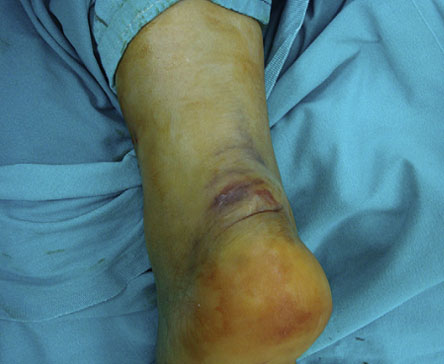Abdullah Eren, MD, Hakan Cift, MD, Korhan Ozkan, MD, Salih Soylemez, MD
Associate Professor, Orthopaedic Surgeon, Department of Orthopaedics and Traumatology, Sb. Medeniyet University Goztepe Education and Research Hospital, Istanbul, Turkey
Orthopaedic Surgeon, Department of Orthopaedics and Traumatology, Sb. Medeniyet University Goztepe Education and Research Hospital, Istanbul, Turkey
Abstract
A number of incision options are available to surgeons approaching the posterior aspect of the calcaneus for repair of fractures of the posterosuperior aspect of the body of the calcaneus. In this brief communication, we depict our preference for the use of a transverse posterior calcaneal incision for reduction and fixation of avulsion fractures of the calcaneus. The advantages of this particular incisional approach include adequate exposure to the underlying target structures, orientation of the scar in line with relaxed skin tension lines, which minimizes scar formation, and avoidance of dissection of the Achilles tendon.
Copyright © 2012 American College of Foot and Ankle Surgeons. Published by Elsevier Inc. All rights reserved.
Avulsion fractures of calcaneal tuberosity are not uncommon and are typically approached through a lateral or posterior longitudinal incision. However, they may occur because of strong concentric contraction of the gastrocnemius-soleus complex with the knee in full extension during sprinting or as a neuropathic fracture in patients with diabetes mellitus. In this article, we aim to present our transverse incision technique in treatment of these fractures, which might be associated with fewer skin problems. The 7 best known skin tension lines are presented. The directions they convey are schematically compared with those of the relaxed skin tension lines.
Commentaries and discussion by the author are provided to help the readers arrive at their own conclusions on which directions their incisions should take so as to obtain the best scarring. In order to obtain the least scarring after a surgical procedure, it is crucial that the surgeon always consider the direction of the relaxed skin tension lines involved in the procedure and attempt to obtain a scar that follows that direction as much as possible. No other factor (except the region where the surgery is to be performed) is as important in obtaining an acceptable scar, including the surgical technique. This article discusses the determination and surgical application of the relaxed skin tension lines.
Surgical Technique
Operations were performed on 2 patients who were diagnosed with calcaneal tuberosity fractures. The first patient was a 32-year-old construction worker who fell from a 1-m height during which his foot came into excessive dorsiflexion. The second patient was a 55-yearold secretary who fell from a chair. She had no history of ankle dorsiflexion but a strong contraction of the gastrocnemius-soleus complex. Radiographs of both patients revealed calcaneal avulsion fractures. In all patients, surgical fixation of the fractured fragment

